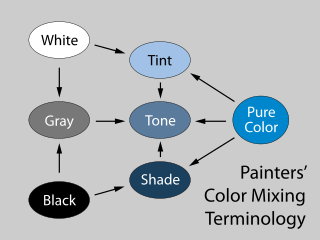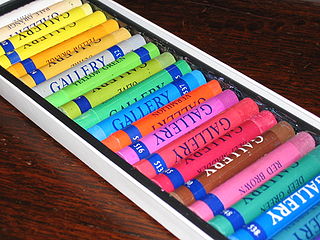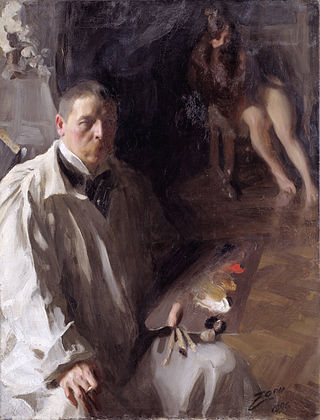Related Research Articles

Green is the color between blue and yellow on the visible spectrum. It is evoked by light which has a dominant wavelength of roughly 495–570 nm. In subtractive color systems, used in painting and color printing, it is created by a combination of yellow and cyan; in the RGB color model, used on television and computer screens, it is one of the additive primary colors, along with red and blue, which are mixed in different combinations to create all other colors. By far the largest contributor to green in nature is chlorophyll, the chemical by which plants photosynthesize and convert sunlight into chemical energy. Many creatures have adapted to their green environments by taking on a green hue themselves as camouflage. Several minerals have a green color, including the emerald, which is colored green by its chromium content.
Sienna is an earth pigment containing iron oxide and manganese oxide. In its natural state, it is yellowish brown, and it is called raw sienna. When heated, it becomes a reddish brown, and it is called burnt sienna. It takes its name from the city-state of Siena, where it was produced during the Renaissance. Along with ochre and umber, it was one of the first pigments to be used by humans, and is found in many cave paintings. Since the Renaissance, it has been one of the brown pigments most widely used by artists.

Brown is a color. It can be considered a composite color, but it is mainly a darker shade of orange. In the CMYK color model used in printing and painting, brown is usually made by combining the colors orange and black. In the RGB color model used to project colors onto television screens and computer monitors, brown combines red and green.

A set of primary colors or primary colours consists of colorants or colored lights that can be mixed in varying amounts to produce a gamut of colors. This is the essential method used to create the perception of a broad range of colors in, e.g., electronic displays, color printing, and paintings. Perceptions associated with a given combination of primary colors can be predicted by an appropriate mixing model that reflects the physics of how light interacts with physical media, and ultimately the retina. The most common color mixing models are the additive primary colors and the subtractive primary colors.

A pigment is a powder used to add color or change visual appearance. Pigments are completely or nearly insoluble and chemically unreactive in water or another medium; in contrast, dyes are colored substances which are soluble or go into solution at some stage in their use. Dyes are often organic compounds whereas pigments are often inorganic. Pigments of prehistoric and historic value include ochre, charcoal, and lapis lazuli.

A monochrome or monochromatic image, object or palette is composed of one color. Images using only shades of grey are called grayscale or black-and-white. In physics, monochromatic light refers to electromagnetic radiation that contains a narrow band of wavelengths, which is a distinct concept.
Color theory, or more specifically traditional color theory, is the historical body of knowledge describing the behavior of colors, namely in color mixing, color contrast effects, color harmony, color schemes and color symbolism. Modern color theory is generally referred to as Color science. While there is no clear distinction in scope, traditional color theory tends to be more subjective and have artistic applications, while color science tends to be more objective and have functional applications, such as in chemistry, astronomy or color reproduction. Color theory dates back at least as far as Aristotle's treatise On Colors. A formalization of "color theory" began in the 18th century, initially within a partisan controversy over Isaac Newton's theory of color and the nature of primary colors. By the end of the 19th century, a schism had formed between traditional color theory and color science.

Umber is a natural earth pigment consisting of iron oxide and manganese oxide; it has a brownish color that can vary among shades of yellow, red, and green. Umber is considered one of the oldest pigments known to humans, first seen in Ajanta Caves in 200 BC – 600 AD. Umber's advantages are its highly versatile color, warm tone, and quick drying abilities. While some sources indicate that umber's name comes from its geographic origin in Umbria, other scholars suggest that it derives from the Latin word umbra, which means "shadow". The belief that its name derives from the word for shadow is fitting, as the color helps create shadows. The color is primarily produced in Cyprus. Umber is typically mined from open pits or underground mines and ground into a fine powder that is washed to remove impurities. In the 20th century, the rise of synthetic dyes decreased the demand for natural pigments such as umber.

Grey or gray is an intermediate color between black and white. It is a neutral or achromatic color, meaning literally that it is "without color", because it can be composed of black and white. It is the color of a cloud-covered sky, of ash, and of lead.

A color wheel or color circle is an abstract illustrative organization of color hues around a circle, which shows the relationships between primary colors, secondary colors, tertiary colors etc.
Chrome yellow is a bright, warm yellow pigment that has been used in art, fashion, and industry. It is the premier orange pigment for many applications.
In color theory, a color scheme is a combination of 2 or more colors used in aesthetic or practical design. Aesthetic color schemes are used to create style and appeal. Colors that create a harmonious feeling when viewed together are often used together in aesthetic color schemes. Practical color schemes are used to inhibit or facilitate color tasks, such as camouflage color schemes or high visibility color schemes. Qualitative and quantitative color schemes are used to encode unordered categorical data and ordered data, respectively. Color schemes are often described in terms of logical combinations of colors on a color wheel or within a color space.
Visual design elements and principles describe fundamental ideas about the practice of visual design.

In color theory, a tint is a mixture of a color with white, which increases lightness, while a shade is a mixture with black, which increases darkness. Both processes affect the resulting color mixture's relative saturation. A tone is produced either by mixing a color with gray, or by both tinting and shading. Mixing a color with any neutral color reduces the chroma, or colorfulness, while the hue remains unchanged.
Varieties of the color red may differ in hue, chroma or lightness, or in two or three of these qualities. Variations in value are also called tints and shades, a tint being a red or other hue mixed with white, a shade being mixed with black. A large selection of these various colors are shown below.

Color psychology is the study of hues as a determinant of human behavior. Color influences perceptions that are not obvious, such as the taste of food. Colors have qualities that can cause certain emotions in people. How color influences individuals may differ depending on age, gender, and culture. Although color associations can vary contextually between cultures, color preference is thought to be relatively uniform across gender and race.
Shades of brown can be produced by combining red, yellow, and black pigments, or by a combination of orange and black—illustrated in the color box. The RGB color model, that generates all colors on computer and television screens, makes brown by combining red and green light at different intensities. Brown color names are often imprecise, and some shades, such as beige, can refer to lighter rather than darker shades of yellow and red. Such colors are less saturated than colors perceived to be orange. Browns are usually described as light or dark, reddish, yellowish, or gray-brown. There are no standardized names for shades of brown; the same shade may have different names on different color lists, and sometimes one name can refer to several very different colors. The X11 color list of web colors has seventeen different shades of brown, but the complete list of browns is much longer.

Pastels or pastel colors belong to a pale family of colors, which, when described in the HSV color space, have high value and low saturation. They are named after an artistic medium made from pigment and solid binding agents, similar to crayons. Pastel sticks historically tended to have lower saturation than paints of the same pigment, hence the name of this color family. The popularity of pastel colors has evolved over time, with notable periods of prominence in various historical and cultural contexts. A significant era that saw a surge in the popularity of pastel colors was the late 19th century, particularly during the Victorian era.

Paint mixing is the practice of mixing components or colors of paint to combine them into a working material and achieve a desired hue. The components that go into paint mixing depend on the function of the product sought to be produced. For example, a painter of portraits or scenery on a canvas may be seeking delicate hues and subtle gradiations, while the painter of a house may be more concerned with durability and consistency of colors in paints presented to customers, and the painter of a bridge or a ship may have the weatherability of the paint as their primary concern.
References
- ↑ "Color Through the Decades: 1970s". Sherwin-Williams.
- ↑ Story, The Design. "Natural and Earthy Tones to Make Trend in 2020?". The Design Story.
- ↑ Braam, Hailey van (18 September 2018). "Warm and Cool Colors: What Are They, How They Are Used & Psychology". Color Psychology.
- ↑ Braam, Hailey van (18 September 2018). "Warm and Cool Colors: What Are They, How They Are Used & Psychology". Color Psychology.
- ↑ "Color Psychology 101: A Beginner's Guide to the Meaning of Colors". Color Psychology.
- ↑ "Color Psychology 101: A Beginner's Guide to the Meaning of Colors". Color Psychology.
- ↑ "Color Psychology 101: A Beginner's Guide to the Meaning of Colors". Color Psychology.
- ↑ "Color Psychology 101: A Beginner's Guide to the Meaning of Colors". Color Psychology.
- ↑ "Color Psychology 101: A Beginner's Guide to the Meaning of Colors". Color Psychology.
- ↑ Spacey, John. "75 Types of Earth Tone". Simplicable.
- ↑ Rimmer, Kelsie (5 August 2020). "Back to Basics: Organic Graphic Design Trends". Envato.
- ↑ Rimmer, Kelsie (5 August 2020). "Back to Basics: Organic Graphic Design Trends". Envato.
- ↑ "Miss Rich: WHY YOUR WARDROBE NEEDS EARTHY COLOUR TONES". Miss Rich.
- ↑ Taggart, Emma (14 December 2022). "Unearth the Colorful History of Paint: From Natural Pigments to Synthetic Hues". My Modern Met.
- ↑ "science of colour - Essential Earth Colours for Art". sites.google.com.
- ↑ "What are Earth Pigments? A Guide to Ochres, Oxides, and Minerals". Natural Earth Paint.
